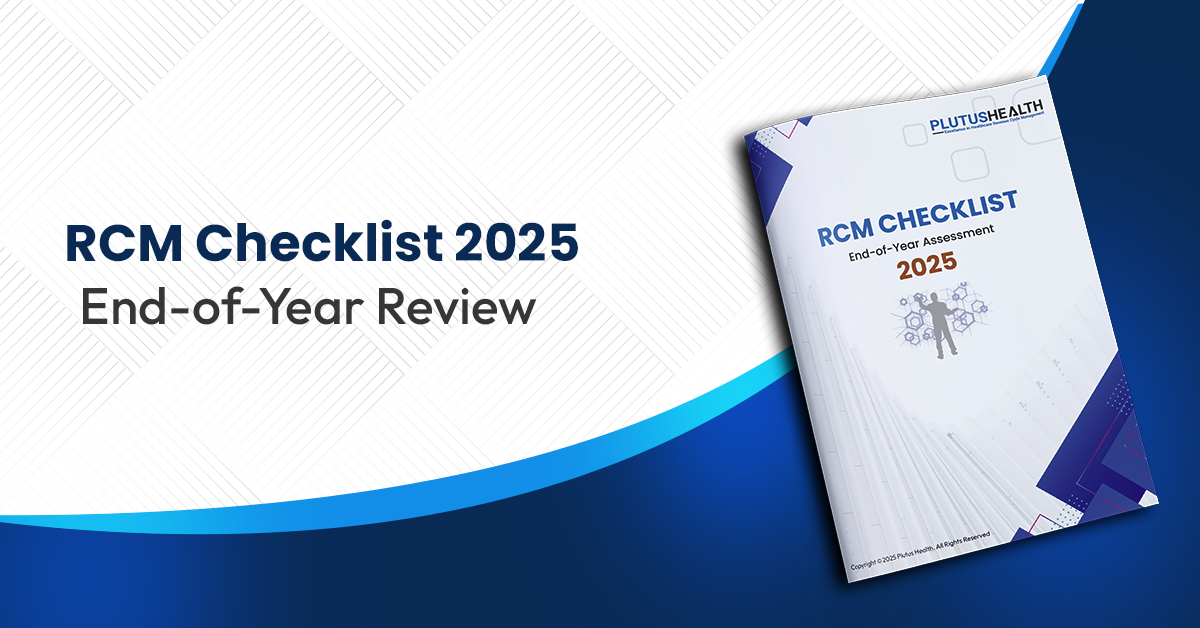Top 7 Trends Reshaping Revenue Cycle Management in 2025
Revenue cycle leaders are entering their Quarter three with urgency, and for good reason.
According to a recent Kaufman Hall report, median hospital operating margins remain below 3%, with 40% of hospitals reporting negative margins in the first quarter of 2025. Meanwhile, Medicare physician reimbursement has declined 29% since 2001 (adjusted for inflation), and commercial payers are tightening documentation and prior authorization requirements across the board.
And yet, the future holds promise. Strategic investments in AI, automation, and end-to-end RCM modernization are helping forward-looking CFOs not only control costs but also improve yield. This blog examines seven trends that are actively reshaping revenue cycle management, trends that every healthcare finance leader needs to understand now.
1. AI Is the Co-pilot of the Future of RCM
The conversation isn't about whether AI can help your revenue cycle. It's about how much longer you'll rely on people to do work machines now handle better, faster, and with zero burnout.
"We used to have 12 coders. Now we have three and an AI engine that hasn't taken a sick day in 18 months." - Director of Revenue Integrity
Here's what most providers get wrong: They use AI like a band-aid, rather than a strategic approach. Meanwhile, forward-leaning systems are replacing entire layers of process with autonomous agents that scrub claims, verify eligibility, and even launch appeals.
In 2025:
- AI bots are managing >57% of eligibility workflows at high-performing systems
- Denial rates are dropping 30–40% where predictive automation replaces manual review
- Labor cost per claim is down 35% at AI-integrated organizations
Your move: Stop piloting AI in silos. Appoint a Revenue AI Officer. Restructure RCM roles around exception management and data oversight, rather than focusing on data entry.
2. Denials Are Not a Problem—They're a Symptom
Most CFOs fixate on denial rates. That's like measuring fever without treating the infection. The real problem? Broken upstream processes, siloed data, and payer policies that are changing faster than your staff can keep up.
Here's the rub: 15–20% of denials are avoidable, but only if you treat them as intelligence, not just noise. If your team's "denial strategy" still includes weekly Excel reports and manual appeals, you don't have a strategy. You have a fire drill.
In 2025:
- Predictive denial modeling is the new standard
- NLP tools auto-analyze remits and surface root causes in real time
- Plutus Health's RPA bot Zeus handles most claims and guarantees a 95% clean claim rate.
Your move: Designate denial prevention as a product function, not a reporting line. Assign a budget, roadmap, and ownership structure, just as you would for IT or clinical operations.
3. The Patient Isn't the Payer. They're the Consumer
Your patients often struggle to understand your bills. They don't want to call your call center. And they don't want to download yet another portal app. This isn't just a UX problem. It's a revenue risk.
The only thing harder than a confusing bill is a silent one. One in three patients won't pay a medical bill they don't understand.
In 2025:
- Text-to-pay, Auto-pay options and Automated reminders are table stakes
- Pre-service financial conversations are boosting point-of-service collections by 18–25%
- Hospitals that brand their billing as a patient experience function are winning trust and dollars
Your move: Treat patient billing like a product. Assign a product manager. A/B test your statements. Measure NPS on your payment flow.
4. Payers Are Outsmarting You—Because They're Already Using AI
Every provider talks about AI. Few ask: What if the payers are already five steps ahead?
In 2025, payer networks are automating pre-authorization decisions, utilizing real-time adjudication engines, and flagging under-documented claims with the aid of machine learning. They're not just pushing the rules, they're rewriting the game in real time.
In 2025:
- Payers are adjusting claims dynamically based on contract heuristics
- Machine-reviewed claims audits are catching edge-case denials that your teams miss
- Real-time APIs mean denials hit faster, and appeal windows shrink
Your move: Build payer-specific intelligence into your RCM platform. Conduct monthly audits to track the evolution of payer behavior. Use AI to predict what's coming before the rejection lands.
5. Cybersecurity Isn't an IT Problem—It's a Revenue Emergency
A cyberattack today doesn't just expose private information, it halts billing, cripples cash flow, and torpedoes trust. And in 2025, cybercrime is no longer a risk. It's a certainty. 79% of detections were malware-free The breach isn't the end of the story, it's the 9–12-month recovery curve that destroys performance targets.
In 2025:
- RCM systems are the #1 target for healthcare cyberattacks
- Cyber liability insurance now requires demonstrated data governance
- Downtime = staff burnout, and missed KPI’s.
Your move: Involve your RCM leaders in cybersecurity drills. Mandate vendor risk reviews. Budget for cyber as a revenue resilience function, not just IT insurance.
6. Your RCM Team Isn't Understaffed- It's Under modeled
Yes, hiring is hard. But throwing bodies at broken processes isn't a workforce strategy. It's a recipe for churn. The real issue? RCM org structures haven't kept pace with the work.
In 2025:
- Top systems operate with 30–40% fewer FTEs, but with better tools and cross-trained talent
- Remote-first RCM models outperform in cost-per-claim
- Smart orgs split their teams: automation managers vs. human judgment zones
Redesign your RCM team structure like a startup org chart. Assign functions by value, not habit. Promote your best analysts to automation strategists.
7. RCM ROI Isn't Optional - It's Your New Financial KPI
In 2025, every CFO should be asking one question: What is the ROI of our revenue cycle?
Not productivity. Not throughput. ROI. Because in a margin-starved environment, effort doesn't matter—outcome does.
- Vendor consolidation isn't just smart, it's mandatory
- RCM dashboards must tie back to enterprise goals (EBITDA, net revenue)
- Stop measuring volume. Measure value.
Your move: Build an RCM P&L and benchmark yourself against top-quartile systems.
Welcome to Strategic RCM.
This isn't a call for more meetings or dashboards. It's a call to rethink the very DNA of how healthcare finance works. The next generation of revenue cycle leaders isn't just billing experts. They're tech translators, AI product owners, and operational futurists.
The question is: Which kind of growth trend can you represent in 2025?
Liked the blog? Share it
FAQs


ABA providers are grappling with high staff turnover (up to 65%), rising burnout, administrative overload, and stagnant reimbursement rates. These challenges directly impact care continuity, clinical outcomes, and operational performance.


Operational inefficiency costs ABA teams up to 10 hours per staff member per week, contributing to burnout, denied claims, and longer accounts receivable (A/R) cycles. These inefficiencies ultimately result in reduced revenue and patient dissatisfaction.


Burnout leads to costly turnover, lower client retention, and decreased productivity. Recruiting and replacing a BCBA or RBT can cost up to $5,000 per hire, plus months of lost revenue and disruption to morale.


High-performing ABA organizations invest in clear career pathways for BCBAs and RBTs, align compensation with market benchmarks, and foster peer-led mentorship, flexible schedules, and wellness programs.


Automation tools like Plutus Health's Zeus streamline eligibility verification, denial management, and billing, reducing manual workloads by 5–10 hours weekly per clinician and improving clean claim rates by 95%.


Outsourcing revenue cycle management can improve collections, reduce denials by up to 30%, and free clinicians from billing-related admin tasks, resulting in better client care and financial outcomes.


One $200 million ABA network partnered with Plutus Health to automate eligibility and accounts receivable (A/R) processes. The result: $2M reduction in legacy A/R and a 97% Net Collection Rate.


By improving operational efficiency, investing in technology, and ensuring workforce stability, ABA leaders can align outcomes with reimbursement. Plutus Health supports this transition with scalable RCM and automation strategies.
FAQs


ABA therapy billing is the process of submitting claims to insurance or Medicaid for Applied Behavior Analysis services provided to individuals with autism or developmental disorders. It includes using correct CPT codes, proper documentation, and adherence to payer-specific policies.


Common CPT codes for ABA therapy in 2025 include:
- 97151 – Assessment and treatment planning
- 97153 – Direct therapy with the patient
- 97155 – Supervision and modification of behavior plan
- 97156 – Family adaptive training
- Always check with payers for any annual changes.


To bill Medicaid for ABA services, providers must ensure credentialing is complete, services are pre-authorized, and claims use the correct codes and modifiers. Medicaid requirements vary by state, so always follow state-specific billing rules.


Common ABA billing mistakes include:
- Incorrect or missing CPT codesplan
- Lack of documentation or treatment
- Uncredentialed providers rendering services
- Submitting duplicate or late claims


Without proper credentialing, providers can’t get reimbursed. Insurance and Medicaid require that BCBAs, RBTs, and organizations are credentialed and contracted. Delays in credentialing often cause revenue losses and claim rejections.
FAQs


CMS proposes a 2.4% increase in Medicare ASC payment rates, contingent on meeting ASCQR quality reporting requirements. Plutus Health helps ASCs meet these compliance benchmarks by integrating quality reporting data into RCM workflows, ensuring eligibility for full payment updates.


The ASC Covered Procedures List will expand by 547 procedures, including cardiology, spine, and vascular surgeries. Plutus Health supports expansion into new service lines by customizing RCM processes for high-acuity procedures, minimizing claim denials during the transition.


Site-neutrality narrows the payment gap with hospital outpatient departments, enhancing ASCs' cost-efficiency appeal. Plutus Health helps leverage this advantage in payer negotiations by providing performance dashboards and cost-justification analytics to secure stronger reimbursement terms.


Complex procedures increase denial risk and slow cash flow. Plutus Health's automation-first RCM model delivers 95%+ clean claim rates, reduces A/R days, and safeguards margins, even as your case mix becomes more complex.
FAQs


A hybrid RCM model combines in-house tasks like scheduling, intake, and patient communication with outsourced billing support for claims, denials, and A/R follow-up. Plutus Health enables this model with automation and expert teams.


Frequent CPT code updates, variable session lengths, high no-show rates, and sensitivity around patient collections make behavioral health billing uniquely challenging. Hybrid RCM helps strike a balance between compliance and patient care.


Tasks requiring patient interaction—like intake, eligibility checks, copay collection, and documentation—are best kept in-house, while backend processes can be outsourced.


Outsourcing denial management, claims scrubbing, and payment posting improves clean claim rates, reduces A/R days, and scales capacity without adding staff.


Plutus Health delivers 97%+ clean claim rates, AI-powered denial prediction, and 48-hour claim turnaround. Our hybrid RCM solutions provide behavioral health CFOs with visibility and control, while enhancing financial performance.
FAQs


Payment complexity, high out-of-pocket costs, increasing denials, and value-based care requirements are pushing providers toward more transparent, tech-supported payment systems.


Patients now act like consumers. They expect clear cost estimates, simple bills, digital payment options, and flexible financing.


AI, automation, and digital tools streamline estimates, reduce denials, support payment plans, and allow faster collections through mobile and online payments.


Complex billing questions, insurance confusion, and financial stress require a compassionate approach. Advocates guide patients and protect trust in clinical care.


Plutus Health supports providers with AI-driven denial prevention, predictive analytics, digital payment tools, patient financing, and a seamless platform, such as AnodynePay.
















































